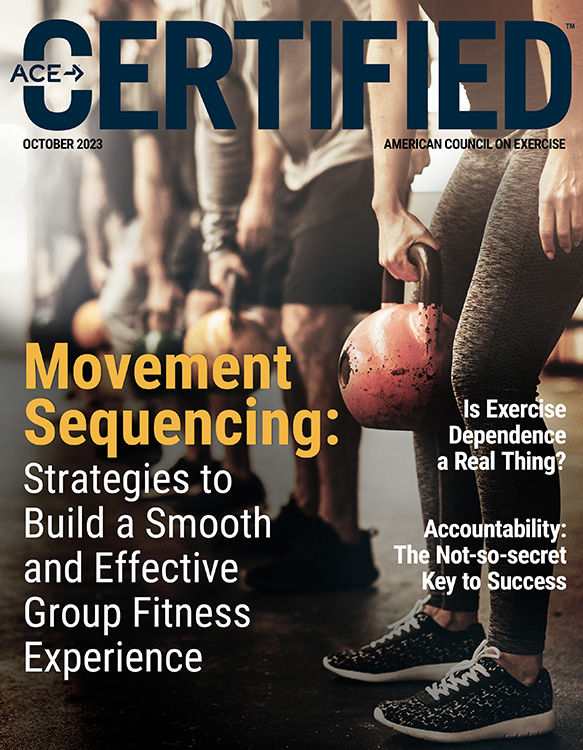
As a health and exercise professional, your job is to inspire others toward healthier living—including engaging in regular exercise. This is a noble endeavor since approximately 85% of American adults do not engage in the recommended amount of both aerobic and muscle-strengthening activity—according to the Centers for Disease Control and Prevention (CDC).
But what happens if one of your clients seems addicted to exercise? Is exercise addiction a real thing—and if so, how do you achieve a healthy amount without letting exercise interfere with other aspects of life? Also, how do you talk to your clients about this issue if you suspect they may be addicted?
Let’s take a deep dive into this topic and try to answer these questions.
What Is Exercise Dependence?
From strengthening the body and bolstering the immune system to improving mental health and decreasing the risk of disease, you know the myriad benefits of regularly engaging in exercise. But when exercise becomes excessive and is the primary focus of an individual’s life, it can create a domino effect of problems.
It’s important to note that exercise dependence or addiction is not yet an official diagnosis in the Diagnostic and Statistical Manual of Mental Disorders (DSM), the bible for psychiatric diagnoses—even though some form of exercise addiction has been discussed in scientific literature since the 1970s, according to a 2021 review in Frontiers in Psychiatry. Although it is not yet an official diagnosis, a 2018 review in Sports Medicine estimates that between 3 and 9% of exercisers may have exercise dependence.
As far as the terms used around this topic, it becomes a bit confusing because researchers may use the terms obligatory exercise, compulsive exercise, exercise addiction and exercise dependence interchangeably. More recently, though, the literature seems to be focusing on two specific terms: compulsive exercise and exercise dependence/addiction.
For example, a 2020 review in the Journal of Clinical Sport Psychology states that the function of compulsive exercise is to avoid the negative affects—like anxiety and guilt—that comes from not exercising. Exercise dependence takes it one step further and is associated with increasing tolerance to exercise benefits—more exercise is needed to obtain the same results or feelings—and avoidance of exercise withdrawal. From this perspective, compulsive exercise is sort of the “gateway drug” to exercise dependence.
A 2023 review in Dialogues in Clinical Neuroscience breaks exercise addiction down into two types: primary exercise addiction and secondary exercise addiction. Essentially, secondary exercise addiction fits the framework for compulsive exercise, whereas primary exercise addiction fits the framework for exercise dependence.
“Compulsive exercise is exercise that is done to the point that problems start to arise,” says Amy Gooding, PsyD, a clinical psychologist with the Eating Recovery Center. “When exercise makes you ignore friends and family, if it is affecting your schoolwork or career, or causing health problems, it may be time to look at your behaviors.”
Essentially, says Chris Gagliardi, MS, scientific education content manager for ACE, problematic exercise begins with compulsive exercise and can progress to exercise dependence. Exercise dependence is a form of “pathological exercise that has been conceptualized as a cluster of cognitive, behavioral and physiological symptoms, similar to those of substance dependence disorders,” explains Gagliardi.
Like other dependence disorders, Gagliardi says that exercise dependence is defined by three or more of the following presentations:
- Tolerance: The need to increase the amount of exercise to achieve desired results; there are also diminished effects with continued use of the same amount of exercise
- Withdrawal: Aversive psychological and physiological symptoms associated with exercise cessation
- Intention effects: Exercising more or for longer than was intended
- Lack of control: Unsuccessful efforts to reduce exercise
- Time: Large amounts of time devoted to exercise
- Reduction in other activities: Exercising instead of engaging in social, occupational or recreational activities
- Continuance: Persistent exercise despite negative physical and/or psychological consequences
More specifically, Gooding, Gagliardi and Eileen Anderson, EdD, director and professor of psychiatry at the School of Medicine at Case Western Reserve, all say that signs of exercise compulsion or dependence can include:
- Making exercise your primary focus, allowing it to take you away from other areas of your life (family, social life, work, etc.)
- Frequently getting injured or exercising despite being injured
- Obsessively thinking about exercise and planning out the details of it
- Experiencing heightened anxiety, agitation or general bad moods if unable to exercise
- Avoiding rest days
- Frequently feeling sick and fatigued (excessive exercise weakens the immune system)
- Refusing to miss a workout
- Engaging in a rigid exercise schedule
- Experiencing medical complications, including a racing heart, dizziness, fainting and hypotension
- Experiencing withdrawal symptoms when exercise is stopped, including insomnia, and mood and appetite changes
- Obsessing about the number of minutes of exercise that must be completed each day
- Denying that there is a problem
As a reminder, it is out of your scope of practice as a health and exercise professional to diagnose any type of problematic exercise. Nor is it necessary for you to try to differentiate between compulsive exercise and exercise dependence. But it is important, says Gooding, to know what to look for.
“Be aware of the signs and have the confidence to discuss this with your clients and make referrals if needed,” advises Gooding.
Are We Perpetuating Exercise Dependence?
From pushing a high calorie burn to focusing on body mass index and body fat, could we be sending the wrong message to our clients that might potentially push them toward exercise dependence?
“Health and exercise professionals should be careful to not focus solely on numbers when assessing progress,” recommends Gooding. “Instead, discuss how exercise is helping them in a more holistic way. Clients should be encouraged to work out with others and engage in types of exercise for fun. Days off from exercise should be encouraged and beliefs about not doing so should be challenged with evidence-based education.”
“The most important thing is what the professional models,” adds Anderson. “If they model balance, self-acceptance and finding joy in exercise, their clients are more likely to as well.”
This includes the language you use. “Professionals can compliment clients’ form, effort, and progress but they should not comment on appearance,” advises Anderson.
Gooding agrees and says to be aware of hurtful messaging around bodies. “Professionals should not tolerate negative self-talk in the fitness environment. Making comments like, ‘You are getting so much stronger,’ is better than ‘Look at how much fat you’ve lost.’”
Gooding also points out that pros should stress to clients that changing their bodies will not fix self-esteem issues. “It can also be very helpful to challenge the pursuit of perfection in the athlete and fitness community,” adds Gooding. “The pursuit of perfection can lead to unhealthy behaviors and beliefs, including constantly pushing oneself and hyper-focusing on one’s perceived flaws.”
Using ACE Frameworks to Broach Difficult Topics with Clients
So, you think your client may be struggling with exercise dependence. Now what?
No matter what type of health and exercise professional you are, there are some topics that are just plain difficult to discuss with clients. After all, the last thing you want to do is shame them or look like a hypocrite in some way. This is where ACE’s Mover Method™ and ABC Approach™ come in.
The ACE Mover Method is a client-centered approach that enables you to be a guide for behavior change and effectively communicate with your clients. The ACE ABC Approach helps you implement the ACE Mover Method and stands by Asking open-ended questions, Breaking down barriers and Collaborating.
When approaching a client about what could be a sensitive subject, Anderson suggests showing up with a nonjudgmental attitude. “Be kind and sincere in your curiosity about your client’s health. They will feel safer to share with you with that attitude.”
Gagliardi feels that it is also important to make the discussion scalable. “The use of screening tools can be helpful to use, not as a diagnostic tool, but as an opportunity to bring about awareness,” suggests Gagliardi.
Some of the screening tools Gagliardi recommends to help open up the conversation include the Revised Exercise Dependence Scale (EDS-R) and the Revised Exercise Addiction Inventory (EAI-R). Both of these are discussed in a 2019 article in the Journal of Behavioral Addictions.
“The use of OARS can be especially powerful as well,” adds Gagliardi.
OARS is part of motivational interviewing and stands for asking Open-ended questions, Affirming a client’s strengths, efforts and resources, Reflective listening and Summarizing.
Here are a few sample questions that Gagliardi says “can be used to draw out more information by inviting clients to reflect before responding.”
- How does your current relationship with exercise impact other areas of your life?
- In what ways does exercise affect your relationships with others?
- How does missing an exercise session affect your mood?
- How much of your free time do you spend exercising?
- What would you have to do to reduce the amount of time you exercise?
- How often do you think about exercise when you should be focused on other tasks?
“Some of these questions may seem strange when compared to the questions we typically ask clients who are wanting to increase exercise, but they can open the door to learning more about a client’s reasons for exercising,” explains Gagliardi.
“It’s also important to know your limits,” concludes Anderson. “If you do not have a mental health degree, you should refer clients on for deeper psychological support. But genuine care and concern from a professional can go a long way to help someone with exercise dependence.”





 by
by 


